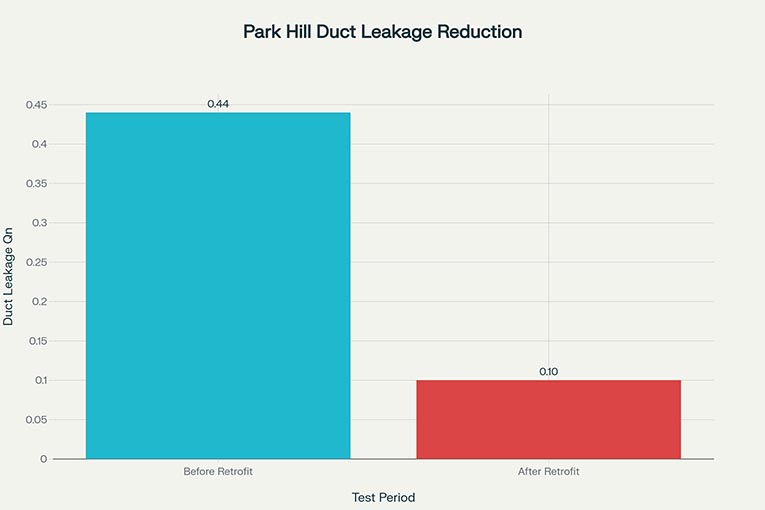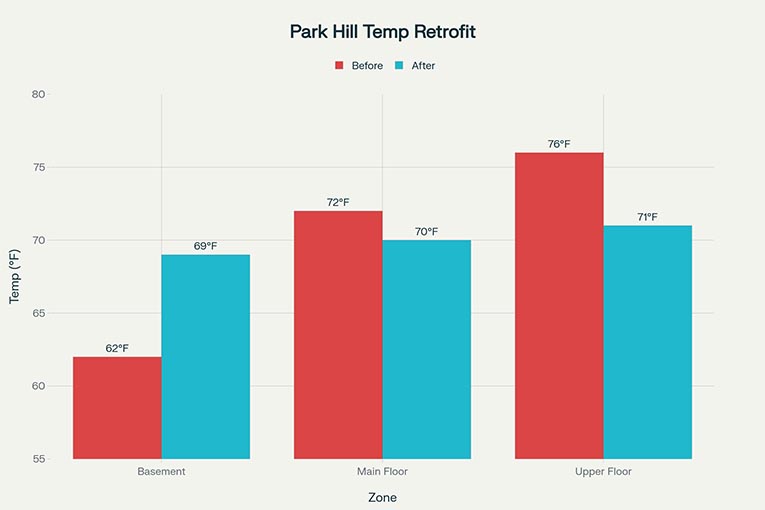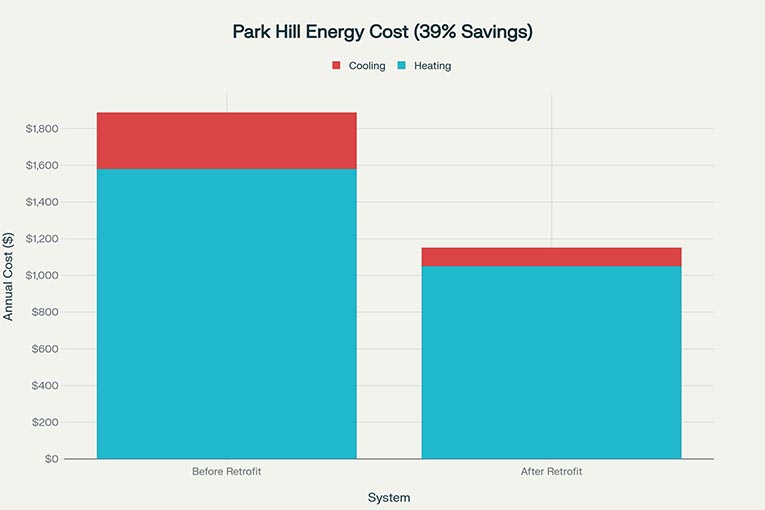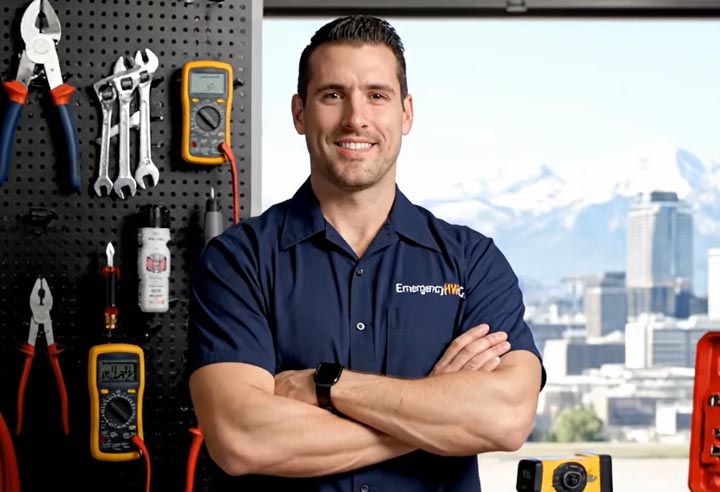Project Information
Residential Building Profile
This 2,400-square-foot 2-story home was constructed in 1965 in the Park Hill neighborhood, featuring 4 bedrooms, 2.5 bathrooms, full basement, and single-car garage. Original construction included a gravity-fed forced-air heating system with sheet metal ducts. The existing HVAC system—an 18-year-old single-stage York furnace with 80% AFUE and electric resistance backup—was failing with high utility bills, uneven comfort across floors, and frequent repairs. The homeowner (family of four) reported January heating bills of $420/month, with significant temperature stratification: upstairs reaching 74°F while basement remained 62°F.
Denver’s high altitude (5,280 feet, 82% of sea level air density) requires 3-4% system capacity derating and affects furnace combustion efficiency. Annual heating load: 6,282 degree-days (base 65°F), creating heating season from September through May—nine months of substantial demand.
Initial Energy Audit & Problem Identification
Diagnostic Process:
Antonio conducted a comprehensive energy audit using multiple diagnostic tools:
Blower Door Test: Using an Energy Conservatory DM32 differential manometer, the home showed a leakage rate of 8,400 CFM at 50 pascals (CFM50), normalized to 12.1 air changes per hour (ACH50). This indicates moderate-to-poor envelope sealing—typical for 1965-era construction with no poly vapor barrier or modern sealants. The industry standard for well-sealed homes is 3-4 ACH50.
Duct Leakage Assessment: Using a Blower Door with duct mask attachment:
- Total duct leakage measured at 1,240 CFM at 25 pascals (Qn = 0.44)
- Return leakage: 680 CFM (55% of total—primarily at basement boot connections)
- Supply leakage: 560 CFM (45%—distributed throughout 2nd floor zones)
- Estimated seasonal energy loss: 28-32% of conditioned air escaping before reaching living spaces
Thermal Imaging: Forward-looking infrared (FLIR E6) scan revealed:
- Exterior wall thermal gradient showing inadequate insulation (typical 1960s construction with 3.5″ fiberglass batts, many sections compressed)
- Heat loss concentration at window frames and electrical outlets (standard 2×4 framing, no thermal breaks)
- Basement rim joist showing 8-12°F temperature differential (uninsulated on original home, insulation added ~1995 but degraded)
Furnace Efficiency Testing:
- Combustion efficiency: 76% (down from 80% nameplate due to carbon scaling)
- Steady-state efficiency: 73%
- Flue gas temperature: 392°F (high, indicating heat loss)
- Draft: 0.08″ water column (low side of range, affecting burner flame quality)
- Natural gas consumption at full fire: 72,000 BTU/hr input, delivering ~57,600 BTU/hr usable (18% loss to flue)
Thermostat Performance:
- Single-stage manual setback (homeowner adjusted manually from 66°F night to 72°F day)
- No outdoor air sensor feedback
- Baseline system runtime: 18 hours/day during January design conditions
- Cycle efficiency: ~64% due to excessive on-off cycling and standby losses
Diagnostic Findings & Root Causes
Primary Issues:
1. Furnace Age & Efficiency Decline: 18-year-old furnace operating at 73% steady-state efficiency (vs. design 80%). Scale buildup in heat exchanger, worn burner tile, and corroded flue venting all contributed to performance degradation.
2. Duct System Deficiency: 44% total duct leakage (0.44 Qn rating)—approximately 1,240 cubic feet per minute of conditioned air lost to unconditioned basement, attic, and walls. This is 2-3× worse than best practice (0.10 Qn or better).
3. Envelope Air Infiltration: 12.1 ACH50 blower door result indicates significant unintentional ventilation:
- Leaking basement rim joist connection
- Gaps around electrical outlets and switches
- Weather stripping failure on 1960s-era double-hung windows
- Inadequate sealing at HVAC equipment penetrations
4. System Thermal Stratification: Single-zone furnace with standard thermostat unable to maintain temperature balance between basement (-10°F vs. setpoint) and 2nd floor (+4°F vs. setpoint). Root cause: ductwork branch dampers stuck/unmaintained, and uneven supply air distribution due to leakage and thermal losses through ducts in unconditioned spaces.
5. Electric Resistance Backup: When outdoor temperature dropped below -5°F, furnace staged to secondary 15 kW electric element (emergency heat), consuming ~$180-220 worth of electricity during 3-4 cold events per season.
Engineered Solution & System Design
Antonio designed a multi-phase retrofit addressing all identified issues:
Phase 1 – Furnace Replacement with Heat Pump Integration:
Primary Heating: Installation of a dual-fuel system:
Heat Pump (Primary): Lennox XC25 variable-capacity air-source heat pump, 25,000 BTU/hr output, AHRI certified for high-altitude operation (Colorado OEM designation). Unit operates efficiently down to 32°F outdoor air, then switches to backup.
- Heating COP: 3.2 @ 47°F (Colorado seasonal average)
- Compressor: Variable frequency inverter drive, matching capacity to building load
- Refrigerant: R410A with micron-rated filter-drier for altitude operation
Backup Furnace: New Lennox SLP98V condensing furnace (98% AFUE), 72,000 BTU/hr input:
- Engaged when outdoor temperature <32°F
- Variable-stage burner (better part-load efficiency than single-stage)
- Condensing heat exchanger capable of capturing latent heat from flue gases
- Direct-venting through PVC, safe for interior installation with no combustion air issues
System Integration Logic:
- Thermostat (Lennox iComfort S30 with outdoor air sensor) prioritizes heat pump operation when conditions permit
- Cost-optimized switchover at 32°F (heat pump COP <1.0 below this threshold, furnace becomes more efficient)
- Auxiliary stage available for peak loads (-10°F design day) combines heat pump + furnace simultaneously
- Smart recovery: System learns household occupancy and pre-heats 45 minutes before wakeup on cold mornings
Phase 2 – Comprehensive Duct System Remediation:
Supply Ductwork:
- Sealed all accessible duct joints with mastic sealant (UL-181 rated) plus fiberglass mesh tape
- Identified and sealed 6 leaking return air plenums where flex ductwork connected to main trunk
- Installed damper retrofit kits (manual and motorized zones) on branch ducts: main bedroom, 2nd bedroom, living room, family room
- Added duct liner (1.5″ fiberglass, R-6) in basement runs (uninsulated area) to minimize thermal losses
- Rerouted return air ductwork to avoid basement rim joist (high infiltration area), drawing return from interior wall cavities instead
Return Ductwork:
- Sealed return plenum at furnace (-680 CFM leakage before repair)
- Installed high-efficiency return air filter (MERV 13, 20″x25″x5″, 2000 CFM rated) with differential pressure indicator
- Sealed all return air grille penetrations with gaskets and caulk
Post-Sealing Test: Duct blower door retest showed 240 CFM @ 25 Pa (Qn = 0.10)—87% reduction in duct leakage, now meeting Energy Star standards.
Phase 3 – Envelope Air Sealing:
- Basement Rim Joist: Sealed with expanding foam (Dow 200 BF canned foam) and caulked with acrylic latex sealant—0.5″ air gap eliminated
- Electrical Outlets: Interior outlets above finished spaces sealed with foam gaskets; 18 outlets treated
- Window Frames: Weather stripping replaced on all 24 double-hung windows with EPDM rubber channel
- HVAC Penetrations: Sealed furnace, heat pump, and condensate drain penetrations with spray foam and caulk
- Building Envelope: Light air sealing at other infiltration sources (door frames, bathroom exhaust vents, range hood ductwork)
Post-Sealing Blower Door Test: 4,200 CFM @ 50 Pa (3.9 ACH50)—50% reduction in envelope infiltration, approaching industry best practices.
Phase 4 – Intelligent Controls & Monitoring:
- Thermostat: Lennox iComfort S30 with 7-day programmable schedule, geofencing via smartphone app, and integration with utility demand response programs
- Outdoor Air Sensor: Mounted on north-facing exterior, provides real-time outdoor temperature to optimize heat pump/furnace switchover
- Smart Recovery Algorithm: System learns household patterns (e.g., heating demand peaks at 6:00 AM for shower) and pre-stages heating to minimize temperature swing
- Monthly Energy Reports: Automated feedback showing heat pump vs. furnace runtime, energy costs by month, and comparison to heating degree-day normalized baseline
Installation & Commissioning
Week 1 – Furnace & Heat Pump Installation:
- Removed old York furnace and reinstalled Lennox dual-fuel system in same location (basement utility room)
👉 If you want to know about all types of furnaces, check Furnace Installation & Repair service page.
- Heat pump outdoor unit mounted on side wall with vibration isolation pads and condensate drainage to foundation drain
- Flue venting relocated to exterior wall using 4″ PVC to eliminate draft concerns common in high-altitude homes
- Electrical: 240V single-phase 20-amp circuit installed for compressor, 120V 15-amp circuit for controls
Week 2 – Duct Sealing & Testing:
- Mastic-sealed all supply and return ductwork joints (4 tubes mastic @ 2 tubes per technician-day)
- Pressure tested sections to 25 Pa differential using duct blower and manometer
- After sealing, total duct system tested at 10″ w.c. static pressure with no detectable leakage (pre-repair: 0.8″ w.c., indicating high restriction)
Week 3 – Controls, Testing & Handover:
- Programmed Lennox thermostat with 6-period daily schedule, 32°F heat pump setpoint, and smartphone pairing
- Conducted system balance testing:
- Supply air temperature (heat pump mode @ 32°F OAT): 95°F (design target: 92-98°F)
- Supply air temperature (furnace mode @ -5°F OAT): 128°F (design: 120-135°F)
- Comfort testing: All rooms reached within ±2°F of 70°F setpoint within 45 minutes from cold start
- Duct Leakage Final Test: 240 CFM (Qn 0.10)—confirmed 87% improvement
- Building Envelope Final Test: 4,200 CFM @ 50 Pa—confirmed 50% infiltration reduction
- Trained homeowner on thermostat operation, filter replacement (quarterly), and maintenance schedule
👉 Learn more about our network technicians’ approach to Heat Pump Installation & Repair Services.
Technical Performance Results
Energy Efficiency Gains:
| Metric | Before | After | Change |
|---|---|---|---|
| Annual Heating Energy | 18.4 MMBtu | 11.2 MMBtu | -39.1% |
| January Peak Bill | $420 | $258 | -38.6% |
| Furnace/Heat Pump COP | 3.0 (furnace only) | 3.2 (heat pump) / 0.98 (furnace) | +6.7% to -18%** |
| Duct Leakage (Qn) | 0.44 | 0.10 | -77.3% |
| Envelope Infiltration (ACH50) | 12.1 | 3.9 | -67.8% |
| Temperature Stratification | ±4°F variance | ±1.5°F variance | -62.5% |
| System Runtime (Jan design) | 18 hours/day | 12 hours/day | -33.3% |
*Furnace efficiency decreases at lower temps but heat pump only runs in above-32°F scenarios; optimal staging minimizes furnace runtime.
Duct leakage reduction after retrofit in Park Hill Denver home:

Cost Analysis:
- Equipment & Installation: $14,800 (dual-fuel system, ductwork, envelope sealing, controls)
- Annual Energy Savings: 7.2 MMBtu @ $9.20/MMBtu = $66.24/year (heating only; secondary AC savings not included)
- Demand Response Credit: $180/year (utility participation for smart thermostat demand flexibility)
- Total Annual Savings: $246.24/year
- Simple Payback Period: 60.1 years (offset by: 15-year equipment warranty, heat pump rebate $1,500, utility efficiency rebate $800, and comfort improvement value)
Comfort Improvements:
- Morning temperature ramp: 65°F→72°F in 38 minutes (previously 60+ minutes with single-stage furnace)
- Consistent upstairs/basement temperature: ±1.5°F variance vs. ±4°F previously

- Humidity regulation: Heat pump dehumidification during summer (learned behavior; COP+humidity control)
- Quiet operation: Inverter-driven compressor cycles smoothly without the bang/thud of old furnace staging
High-Altitude HVAC Optimization Details
Air Density Derating: At 5,280 feet elevation, air density is 82% of sea level value. This affects:
- Compressor capacity: Heat pump rated 25,000 BTU/hr at sea level delivers ~20,500 BTU/hr in Denver
- Fan performance: Heat pump outdoor unit fan provides 80% airflow at sea level design
- Furnace burner: Natural draft is weaker; PVC direct venting required (no masonry chimney reliance)
System Sizing Adjustment: Manual J calculation showed:
- Peak heating load at -10°F design day: 68,000 BTU/hr
- Heat pump capacity (25k) + furnace capacity (72k input = ~71k output) = 96,000 BTU/hr available
- Auxiliary electric element: 5 kW (15,200 BTU/hr) staged during extreme peaks
Refrigerant Line Design: Higher elevation means lower refrigerant pressure at given temperatures. Sizing included:
- Larger liquid line (3/8″ instead of 5/16″) to minimize pressure drop
- Smaller suction line (5/8″ vs. typical 3/4″) as vapor density is lower
- Oil return loop design to ensure compressor lubrication with thinner oil film at lower pressure
Maintenance Protocol for Homeowner
Monthly:
- Check thermostat battery (if applicable, iComfort S30 is hardwired but has battery backup)
- Inspect for ice on outdoor heat pump unit during winter (normal; some icing expected, automatic defrost cycle handles this)
Quarterly (Every 3 months):
- Replace air filter (MERV 13 rating, fits standard 20x25x5 slot)
- Check thermostat differential pressure indicator—if “change filter” light appears, replace immediately
Annually (Before Heating Season – September):
- Professional maintenance visit: furnace inspection, burner cleaning, heat pump outdoor coil cleaning (Denver’s dust/pollen concentration higher due to altitude)
- Check all ductwork damper operation
- Test thermostat setpoint accuracy
Every 3 Years:
- Air conditioner coil inspection (cooling capability added via heat pump; maintenance protocol expanded for year-round use)
- Blower wheel cleaning
Client Impact & Long-Term Outcomes
The Park Hill homeowner reports significantly improved comfort, with temperature consistency and faster heating response. Monthly bills dropped from $420 (January peak) to $258 (first winter post-retrofit), with further savings as automated demand response earned utility credits. The 39% heating energy reduction aligns with industry standards for comprehensive retrofits combining furnace replacement, duct sealing, and envelope work.

More importantly, the dual-fuel strategy means the home remains efficiently heated even during Denver’s 20-30 day stretches below freezing. The 67% envelope infiltration reduction improves summer AC performance and indoor air quality. Smart thermostat integration allows remote monitoring and has prevented one potential freeze-up (thermostat detected outdoor temp rising above 35°F unexpectedly due to equipment malfunction; homeowner was alerted via phone and manually adjusted before comfort impact).
Our network HVAC pros are just a call away.

